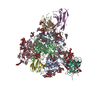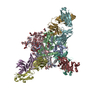+ Open data
Open data
- Basic information
Basic information
| Entry | Database: PDB / ID: 8t5c | |||||||||
|---|---|---|---|---|---|---|---|---|---|---|
| Title | Lassa GPC Trimer in complex with Fab 8.11G and nanobody D5 | |||||||||
 Components Components |
| |||||||||
 Keywords Keywords |  VIRAL PROTEIN/IMMUNE SYSTEM / VIRAL PROTEIN/IMMUNE SYSTEM /  vaccine / GPC / GP1 / GP2 / vaccine / GPC / GP1 / GP2 /  VIRAL PROTEIN-IMMUNE SYSTEM complex VIRAL PROTEIN-IMMUNE SYSTEM complex | |||||||||
| Function / homology |  Function and homology information Function and homology informationhost cell Golgi membrane / receptor-mediated endocytosis of virus by host cell / host cell endoplasmic reticulum membrane / fusion of virus membrane with host endosome membrane /  viral envelope / virion attachment to host cell / host cell plasma membrane / virion membrane / viral envelope / virion attachment to host cell / host cell plasma membrane / virion membrane /  membrane / membrane /  metal ion binding metal ion bindingSimilarity search - Function | |||||||||
| Biological species |   Lassa virus Josiah Lassa virus Josiah  Camelus bactrianus (Bactrian camel) Camelus bactrianus (Bactrian camel)  Homo sapiens (human) Homo sapiens (human) | |||||||||
| Method |  ELECTRON MICROSCOPY / ELECTRON MICROSCOPY /  single particle reconstruction / single particle reconstruction /  cryo EM / Resolution: 4.7 Å cryo EM / Resolution: 4.7 Å | |||||||||
 Authors Authors | Gorman, J. / Kwong, P.D. | |||||||||
| Funding support |  United States, 2items United States, 2items
| |||||||||
 Citation Citation |  Journal: Nat Commun / Year: 2024 Journal: Nat Commun / Year: 2024Title: Cleavage-intermediate Lassa virus trimer elicits neutralizing responses, identifies neutralizing nanobodies, and reveals an apex-situated site-of-vulnerability. Authors: Jason Gorman / Crystal Sao-Fong Cheung / Zhijian Duan / Li Ou / Maple Wang / Xuejun Chen / Cheng Cheng / Andrea Biju / Yaping Sun / Pengfei Wang / Yongping Yang / Baoshan Zhang / Jeffrey C ...Authors: Jason Gorman / Crystal Sao-Fong Cheung / Zhijian Duan / Li Ou / Maple Wang / Xuejun Chen / Cheng Cheng / Andrea Biju / Yaping Sun / Pengfei Wang / Yongping Yang / Baoshan Zhang / Jeffrey C Boyington / Tatsiana Bylund / Sam Charaf / Steven J Chen / Haijuan Du / Amy R Henry / Tracy Liu / Edward K Sarfo / Chaim A Schramm / Chen-Hsiang Shen / Tyler Stephens / I-Ting Teng / John-Paul Todd / Yaroslav Tsybovsky / Raffaello Verardi / Danyi Wang / Shuishu Wang / Zhantong Wang / Cheng-Yan Zheng / Tongqing Zhou / Daniel C Douek / John R Mascola / David D Ho / Mitchell Ho / Peter D Kwong /  Abstract: Lassa virus (LASV) infection is expanding outside its traditionally endemic areas in West Africa, posing a pandemic biothreat. LASV-neutralizing antibodies, moreover, have proven difficult to elicit. ...Lassa virus (LASV) infection is expanding outside its traditionally endemic areas in West Africa, posing a pandemic biothreat. LASV-neutralizing antibodies, moreover, have proven difficult to elicit. To gain insight into LASV neutralization, here we develop a prefusion-stabilized LASV glycoprotein trimer (GPC), pan it against phage libraries comprising single-domain antibodies (nanobodies) from shark and camel, and identify one, D5, which neutralizes LASV. Cryo-EM analyses reveal D5 to recognize a cleavage-dependent site-of-vulnerability at the trimer apex. The recognized site appears specific to GPC intermediates, with protomers lacking full cleavage between GP1 and GP2 subunits. Guinea pig immunizations with the prefusion-stabilized cleavage-intermediate LASV GPC, first as trimer and then as a nanoparticle, induce neutralizing responses, targeting multiple epitopes including that of D5; we identify a neutralizing antibody (GP23) from the immunized guinea pigs. Collectively, our findings define a prefusion-stabilized GPC trimer, reveal an apex-situated site-of-vulnerability, and demonstrate elicitation of LASV-neutralizing responses by a cleavage-intermediate LASV trimer. | |||||||||
| History |
|
- Structure visualization
Structure visualization
| Structure viewer | Molecule:  Molmil Molmil Jmol/JSmol Jmol/JSmol |
|---|
- Downloads & links
Downloads & links
- Download
Download
| PDBx/mmCIF format |  8t5c.cif.gz 8t5c.cif.gz | 322.9 KB | Display |  PDBx/mmCIF format PDBx/mmCIF format |
|---|---|---|---|---|
| PDB format |  pdb8t5c.ent.gz pdb8t5c.ent.gz | 267.9 KB | Display |  PDB format PDB format |
| PDBx/mmJSON format |  8t5c.json.gz 8t5c.json.gz | Tree view |  PDBx/mmJSON format PDBx/mmJSON format | |
| Others |  Other downloads Other downloads |
-Validation report
| Arichive directory |  https://data.pdbj.org/pub/pdb/validation_reports/t5/8t5c https://data.pdbj.org/pub/pdb/validation_reports/t5/8t5c ftp://data.pdbj.org/pub/pdb/validation_reports/t5/8t5c ftp://data.pdbj.org/pub/pdb/validation_reports/t5/8t5c | HTTPS FTP |
|---|
-Related structure data
| Related structure data |  41048MC M: map data used to model this data C: citing same article ( |
|---|---|
| Similar structure data | Similarity search - Function & homology  F&H Search F&H Search |
- Links
Links
- Assembly
Assembly
| Deposited unit | 
|
|---|---|
| 1 |
|
- Components
Components
-Glycoprotein ... , 2 types, 6 molecules BACbac
| #1: Protein | Mass: 22884.879 Da / Num. of mol.: 3 Source method: isolated from a genetically manipulated source Source: (gene. exp.)   Lassa virus Josiah / Gene: GPC, GP-C / Production host: Lassa virus Josiah / Gene: GPC, GP-C / Production host:   Homo sapiens (human) / References: UniProt: P08669 Homo sapiens (human) / References: UniProt: P08669#2: Protein | Mass: 22143.170 Da / Num. of mol.: 3 Source method: isolated from a genetically manipulated source Source: (gene. exp.)   Lassa virus Josiah / Gene: GPC, GP-C / Production host: Lassa virus Josiah / Gene: GPC, GP-C / Production host:   Homo sapiens (human) / References: UniProt: P08669 Homo sapiens (human) / References: UniProt: P08669 |
|---|
-Antibody , 3 types, 5 molecules DHELI
| #3: Antibody | Mass: 13228.544 Da / Num. of mol.: 1 Source method: isolated from a genetically manipulated source Source: (gene. exp.)   Camelus bactrianus (Bactrian camel) / Production host: Camelus bactrianus (Bactrian camel) / Production host:   Homo sapiens (human) Homo sapiens (human) | ||
|---|---|---|---|
| #4: Antibody | Mass: 13257.604 Da / Num. of mol.: 2 Source method: isolated from a genetically manipulated source Source: (gene. exp.)   Homo sapiens (human) / Production host: Homo sapiens (human) / Production host:   Homo sapiens (human) Homo sapiens (human)#5: Antibody | Mass: 12101.508 Da / Num. of mol.: 2 Source method: isolated from a genetically manipulated source Source: (gene. exp.)   Homo sapiens (human) / Production host: Homo sapiens (human) / Production host:   Homo sapiens (human) Homo sapiens (human) |
-Sugars , 9 types, 39 molecules 
| #6: Polysaccharide | alpha-D-mannopyranose-(1-2)-alpha-D-mannopyranose-(1-3)-[alpha-D-mannopyranose-(1-3)-[alpha-D- ...alpha-D-mannopyranose-(1-2)-alpha-D-mannopyranose-(1-3)-[alpha-D-mannopyranose-(1-3)-[alpha-D-mannopyranose-(1-6)]alpha-D-mannopyranose-(1-6)]beta-D-mannopyranose-(1-4)-2-acetamido-2-deoxy-beta-D-glucopyranose-(1-4)-2-acetamido-2-deoxy-beta-D-glucopyranose / Mass: 1397.245 Da / Num. of mol.: 1 / Mass: 1397.245 Da / Num. of mol.: 1Source method: isolated from a genetically manipulated source | ||||||||||||||
|---|---|---|---|---|---|---|---|---|---|---|---|---|---|---|---|
| #7: Polysaccharide | beta-D-mannopyranose-(1-4)-2-acetamido-2-deoxy-beta-D-glucopyranose-(1-4)-2-acetamido-2-deoxy-beta- ...beta-D-mannopyranose-(1-4)-2-acetamido-2-deoxy-beta-D-glucopyranose-(1-4)-2-acetamido-2-deoxy-beta-D-glucopyranose  / Mass: 586.542 Da / Num. of mol.: 4 / Mass: 586.542 Da / Num. of mol.: 4Source method: isolated from a genetically manipulated source #8: Polysaccharide |  / Mass: 383.349 Da / Num. of mol.: 3 / Mass: 383.349 Da / Num. of mol.: 3Source method: isolated from a genetically manipulated source #9: Polysaccharide |  / Mass: 1072.964 Da / Num. of mol.: 3 / Mass: 1072.964 Da / Num. of mol.: 3Source method: isolated from a genetically manipulated source #10: Polysaccharide |  / Mass: 910.823 Da / Num. of mol.: 2 / Mass: 910.823 Da / Num. of mol.: 2Source method: isolated from a genetically manipulated source #11: Polysaccharide | alpha-D-mannopyranose-(1-2)-alpha-D-mannopyranose-(1-3)-beta-D-mannopyranose-(1-4)-2-acetamido-2- ...alpha-D-mannopyranose-(1-2)-alpha-D-mannopyranose-(1-3)-beta-D-mannopyranose-(1-4)-2-acetamido-2-deoxy-beta-D-glucopyranose-(1-4)-2-acetamido-2-deoxy-beta-D-glucopyranose |  / Mass: 910.823 Da / Num. of mol.: 1 / Mass: 910.823 Da / Num. of mol.: 1Source method: isolated from a genetically manipulated source #12: Polysaccharide | alpha-D-mannopyranose-(1-3)-[alpha-D-mannopyranose-(1-6)]alpha-D-mannopyranose |  / Mass: 504.438 Da / Num. of mol.: 1 / Mass: 504.438 Da / Num. of mol.: 1Source method: isolated from a genetically manipulated source #13: Polysaccharide | alpha-D-mannopyranose-(1-6)-alpha-D-mannopyranose-(1-6)-[alpha-D-mannopyranose-(1-3)]beta-D- ...alpha-D-mannopyranose-(1-6)-alpha-D-mannopyranose-(1-6)-[alpha-D-mannopyranose-(1-3)]beta-D-mannopyranose-(1-4)-2-acetamido-2-deoxy-beta-D-glucopyranose-(1-4)-2-acetamido-2-deoxy-beta-D-glucopyranose |  / Mass: 1072.964 Da / Num. of mol.: 1 / Mass: 1072.964 Da / Num. of mol.: 1Source method: isolated from a genetically manipulated source #14: Sugar | ChemComp-NAG /  N-Acetylglucosamine N-Acetylglucosamine |
-Details
| Has ligand of interest | N |
|---|
-Experimental details
-Experiment
| Experiment | Method:  ELECTRON MICROSCOPY ELECTRON MICROSCOPY |
|---|---|
| EM experiment | Aggregation state: PARTICLE / 3D reconstruction method:  single particle reconstruction single particle reconstruction |
- Sample preparation
Sample preparation
| Component | Name: Lassa GPC Trimer in complex with Fab 8.11G and nanobody D5 Type: COMPLEX / Entity ID: #1-#5 / Source: MULTIPLE SOURCES | ||||||||||||||||
|---|---|---|---|---|---|---|---|---|---|---|---|---|---|---|---|---|---|
| Molecular weight | Experimental value: NO | ||||||||||||||||
| Source (natural) |
| ||||||||||||||||
| Source (recombinant) | Organism:   Homo sapiens (human) Homo sapiens (human) | ||||||||||||||||
| Buffer solution | pH: 7.4 / Details: PBS | ||||||||||||||||
| Specimen | Conc.: 2 mg/ml / Embedding applied: NO / Shadowing applied: NO / Staining applied : NO / Vitrification applied : NO / Vitrification applied : YES : YES | ||||||||||||||||
Vitrification | Instrument: FEI VITROBOT MARK IV / Cryogen name: ETHANE / Humidity: 90 % / Chamber temperature: 293 K |
- Electron microscopy imaging
Electron microscopy imaging
| Experimental equipment |  Model: Titan Krios / Image courtesy: FEI Company |
|---|---|
| Microscopy | Model: FEI TITAN KRIOS |
| Electron gun | Electron source : :  FIELD EMISSION GUN / Accelerating voltage: 300 kV / Illumination mode: FLOOD BEAM FIELD EMISSION GUN / Accelerating voltage: 300 kV / Illumination mode: FLOOD BEAM |
| Electron lens | Mode: BRIGHT FIELD Bright-field microscopy / Nominal defocus max: 2500 nm / Nominal defocus min: 1000 nm / C2 aperture diameter: 70 µm Bright-field microscopy / Nominal defocus max: 2500 nm / Nominal defocus min: 1000 nm / C2 aperture diameter: 70 µm |
| Image recording | Average exposure time: 2 sec. / Electron dose: 51.15 e/Å2 / Detector mode: COUNTING / Film or detector model: GATAN K3 (6k x 4k) / Num. of grids imaged: 1 |
- Processing
Processing
| EM software |
| ||||||||||||||||||||||||
|---|---|---|---|---|---|---|---|---|---|---|---|---|---|---|---|---|---|---|---|---|---|---|---|---|---|
CTF correction | Type: PHASE FLIPPING AND AMPLITUDE CORRECTION | ||||||||||||||||||||||||
| Symmetry | Point symmetry : C1 (asymmetric) : C1 (asymmetric) | ||||||||||||||||||||||||
3D reconstruction | Resolution: 4.7 Å / Resolution method: FSC 0.143 CUT-OFF / Num. of particles: 109878 / Symmetry type: POINT | ||||||||||||||||||||||||
| Atomic model building | Protocol: FLEXIBLE FIT / Space: REAL | ||||||||||||||||||||||||
| Atomic model building | PDB-ID: 5VK2 Accession code: 5VK2 / Source name: PDB / Type: experimental model |
 Movie
Movie Controller
Controller






 PDBj
PDBj




